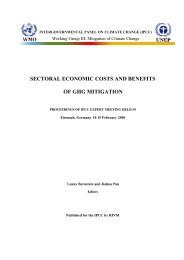Pacific Islands Environment Outlook - UNEP
Pacific Islands Environment Outlook - UNEP
Pacific Islands Environment Outlook - UNEP
Create successful ePaper yourself
Turn your PDF publications into a flip-book with our unique Google optimized e-Paper software.
36<br />
POLICY RESPONSES<br />
sector reform programmes through the Forum Economic<br />
Ministers’ Meeting (FEMM), and the South <strong>Pacific</strong><br />
Organizations Coordinating Committee (SPOCC)<br />
Regional Development Strategy and working groups on<br />
marine resources and tourism.<br />
Global Programme of Action for the Protection<br />
of the Marine <strong>Environment</strong> from Land-Based<br />
Activities<br />
The international community adopted the Global<br />
Programme of Action for the Protection of the Marine<br />
<strong>Environment</strong> from Land Based Activities in Washington<br />
DC in 1995. While a range of national and regional<br />
initiatives have attempted to address the issues of source<br />
categories covered by the GPA, no specific initiative has<br />
been taken to implement the GPA in the <strong>Pacific</strong> region<br />
(SPREP 1999a). The first steps to develop a<br />
complementary Regional Programme of Action are<br />
expected to take place in 1999.<br />
REGIONAL<br />
A number of non-binding environmental agreements<br />
operate in the <strong>Pacific</strong>. Most of these agreements have<br />
translated into specific programmes and are consistent<br />
with the objectives of Agenda 21.<br />
The principal agreement for environmental<br />
protection is the SPREP Action Plan 1997–2000. This is<br />
a requirement of the Agreement Establishing SPREP<br />
Figure 2.1: Change in staffing levels of environment units in<br />
selected PICs<br />
1990<br />
5<br />
4<br />
3<br />
3<br />
3<br />
1<br />
1<br />
Source: after Miles (1994)<br />
Kiribati<br />
Fiji<br />
Palau<br />
Solomon <strong>Islands</strong><br />
Tokelau<br />
Tuvalu<br />
Vanuatu<br />
Western Samoa<br />
1<br />
2<br />
1995<br />
5<br />
5<br />
6<br />
7<br />
includes 3 atoll co-ordinators<br />
8<br />
includes 3 project staff<br />
12<br />
(1995), which gave the South <strong>Pacific</strong> Regional<br />
<strong>Environment</strong> Programme (SPREP) new legal status and a<br />
framework for members to improve co-ordination on<br />
environmental matters and to protect and improve the<br />
shared environment of <strong>Pacific</strong> island states. The<br />
programmes contained in the Action Plan cover a wide<br />
range of detailed environmental issues. The five<br />
priorities identified in the Action Plan are:<br />
1. Biodiversity and Natural Resource Conservation<br />
2. Climate Change and Integrated Coastal Management<br />
3. Waste Management, Pollution Prevention and<br />
Emergencies<br />
4. <strong>Environment</strong>al Management, Planning and<br />
Institutional Strengthening<br />
5. <strong>Environment</strong>al Education, Information and Training<br />
Related to the implementation of the Action Plan,<br />
governments and NGOs have agreed to an Action<br />
Strategy for the Conservation of Nature and Natural<br />
Resources. This was revised in 1998 and is now the<br />
focus for a series of donor/institution/NGO round-tables<br />
to promote its implementation.<br />
Laws and institutions<br />
Institutional and legal frameworks at<br />
national level<br />
While it may be difficult to demonstrate categorically<br />
where there has been progress to protect the<br />
environment at the national level, some of the policy<br />
and institutional foundations for progress towards<br />
sustainable development are being put in place. These<br />
include the strengthening of environment units and the<br />
adoption of National <strong>Environment</strong>al Management<br />
Strategies (NEMS).<br />
The capacity of countries to undertake activities to<br />
protect the environment and to integrate environmental<br />
objectives into national planning and decision-making is a<br />
useful measure of progress. Any increase in the number<br />
of staff in environment units, particularly at a time when<br />
the public sector is under pressure to downsize, is an<br />
indication that governments are making some<br />
commitment towards the implementation of Agenda 21.<br />
Not all positions are financed solely from government<br />
funds but those that are financed through official<br />
development assistance result from government requests<br />
for assistance and are normally linked to the provision of<br />
counterparts and logistic support. As shown in Figure 2.1<br />
there has been a discernible increase in the region.

















